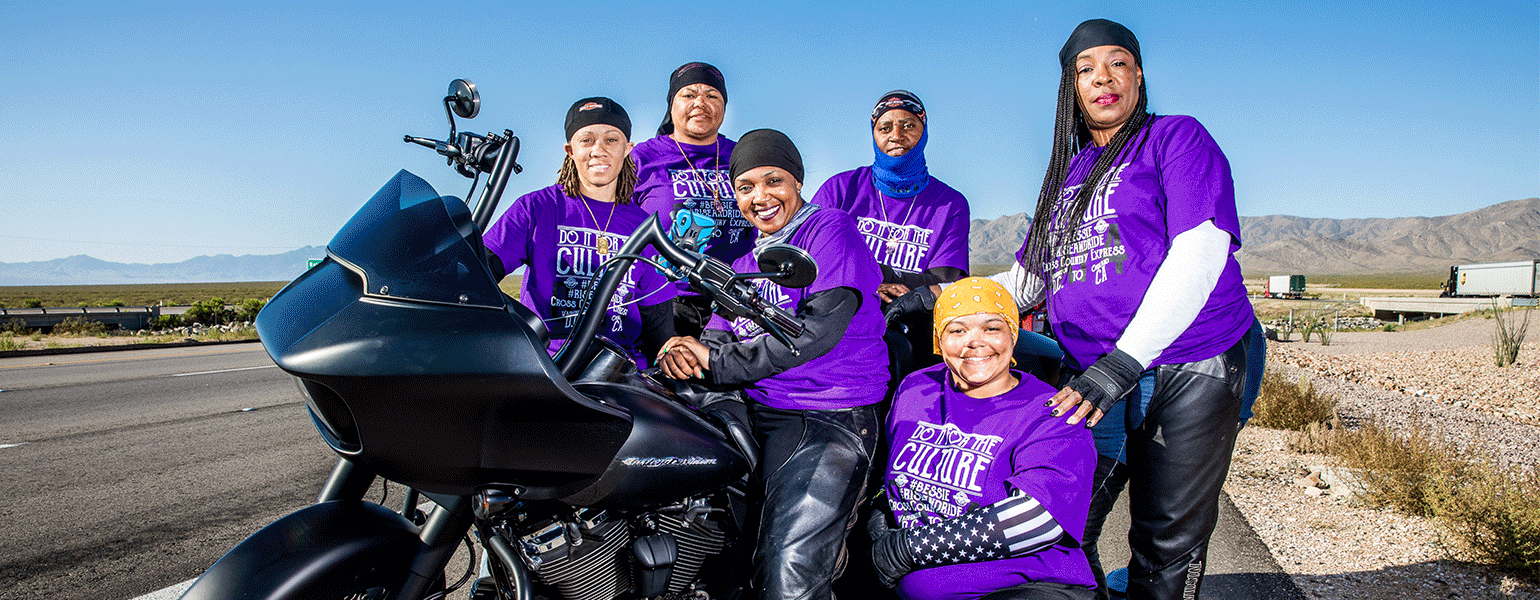Tameka “Kurvez” Richardson looked into the rearview mirror of her black Harley Davidson Road Glide and cried.
Behind her more than 100 women, also on steel horses, were crossing the state line from Nevada into California, their motorcycles glistening in the fierce summer sun. Their purple shirts, emblazoned with the words “Do It for the Culture,” proclaimed that, despite disparate ages, races, abilities, occupations and hometowns, they were, as Frankie Beverly and Maze might say, one. One in their love of biking. One in their need to bond with like-minded sisters. One in their desire to see the country. For about a year Kurvez (pronounced curves) and a small group of women had planned this cross-country trip; now, the visual manifestation of their hard work caused Kurvez to literally shed tears of bittersweet joy.
This was the sixth annual Bessie Stringfield All Female Ride.
“When we got to the California state line, we got off our bikes to take a picture,” Kurvez recalls. “That was something to see.”
Bessie Stringfield would have been proud.
In the 1930s, Stringfield became the first African American woman to cross the country on a motorcycle. Word is that Stringfield would toss a penny in the air, and wherever it landed on the map, that was her next destination. She made eight solo cross-country trips in all, roaming a nation whose interstate highway system had not yet been built but whose Jim Crow system was very much intact. Stringfield traveled the back roads, relying on the kindness of strangers to help her along the way. To honor her bold, adventurous spirit, in 2014 Kurvez and five other women created and went on the first Bessie Stringfield All Female Ride. By 2018, 350 ladies were riding with them on trips that ranged from one to four days. The group regularly raised money for charities; this year’s beneficiaries were a shelter for victims of domestic violence in Pennsylvania and the American Heart Association (Stringfield died of an enlarged heart). This year was the group’s first cross-country event, and for most riders it took ten days to complete. Billed as a family affair, even a few men joined in.
There is a kinship among bikers, a bond that knits them together as securely as any sorority or religious institution. While the fancy helmets and funny nicknames are cute, the bond goes deeper than that. Bikers speak the language of the open road, delighting at the wind in their faces and the power between their thighs. They are free. Free to explore. Free to commune with nature. Free to assess and reassess their lives, to contemplate problems and make plans without the constraints typically found at home. The bike roars and the music plays and they think about fractured relationships or health challenges or disappointing jobs. “We call it wind therapy or two-wheel therapy,” says Kurvez. Maybe decisions are reached, maybe not. It’s in the exploratory process that another level of freedom is sometimes attained.
Everyone’s ride is different. Some women prefer to travel on cruisers, large bikes tricked out with the latest amenities, while others mount speedier, sportier wheels. Some want to pound (or ride hard) like Bessie did, going great distances in a short amount of time, while others prefer a slower ride, giving them space to stop and smell the flowers along the way.
This cross-country trip allowed everyone to do their own thing. Participants were instructed to take either Interstate 10 out of Jacksonville or I-40 or I-70 out of the Washington, D.C., area and then meet up in Las Vegas at a specific date and time. Once there, they’d connect at a “Chat ’N Chew,” or an empowerment session, where women who’d been riding for 30 or 40 years would share their experiences. Then, after a night’s rest, the group would travel, en masse, into California. The official motto of the Stringfield group puts it like this: Rise and Ride.
So from Mississippi and Texas, Illinois and Massachusetts, the bikers came. On blue Harleys and red and black Sportsters, they came. Traveling solo or with friends — even with pets — they came. For some, the trip was about stepping out of their comfort zones, for others it was about solidifying friendships. Still others saw it as an opportunity to test limits. The Atlanta-based Kurvez, 45, and fellow Atlantan (and Stringfield committee member) Dolly “Jus’Tis” Johnson, 56, joined 30 other people in completing the aptly-named IronButt Challenge, meaning that challengers either rode 1,500 miles in 24 hours (bun burners) or 1,000 miles in 24 hours (saddle sores). Can you say ouch? Naturally, there were bikers who rode less aggressively, posing for pictures in front of the Hoover Dam or Grand Canyon. Regardless of how they made it to Las Vegas, they made it. Or at least most of them did.
"Motorcyclists and their passengers are more vulnerable to the hazards of weather and road conditions than drivers in closed vehicles," notes the Insurance Information Institute. For every 100,000 registered motorcycles in 2016, there were 60 fatalities. In an effort to circumvent heavy rains in Colorado, two bikers on the Bessie Stringfield All Female Ride sought an alternate route and wound up in a blinding hailstorm. The lead rider, an experienced 52-year-old named Rachelle “Navigator” Green, crashed into the back of a truck and was killed. A day later, at the Chat ’N Chew in Las Vegas, the somber biker sisterhood discussed the tragedy and their feelings of anguish and loss — but few (if any) wanted to give up and go home. “Everybody was sad about it,” Kurvez says, “but it was like, ‘This (the cross-country ride) is what we came to do. Let’s finish.’”
And so they did. Once in California, the bikers made pre-planned stops every 100 miles and were greeted by cheering friends and onlookers who plied them with Gatorade, bananas, water and trail mix. For 19-year-old Delshateki “Dirty Bird” Izquierdo, the trip had already been special. Accompanied by her mom, ThunderKat (Ruby), and her dad, Big Hump (Deleones), the trio rode from their home in Killeen, Texas, to Washington, D.C., where they linked up with others for the IronButt challenge. In Las Vegas, much to her surprise, Dirty Bird was honored with the Young Bessie award. “That blew my mind because what Ms. Bessie did in her time was incredible,” Dirty Bird says. “Then to be put on a pedestal underneath her name — that’s very humbling.” But the icing on the cake was what Dirty Bird saw and felt when riding into California. “You look to your left and see little children staring at you. Then over to your right, people are pulled over taking videos of you,” she says. It was powerful. “To see everybody together, happy. All those people ….”
Jus’Tis, one of the oldest riders to make the trip, agrees. She says that perhaps more important than the journey itself was observing how finishing the journey made some women feel. “Seeing women who really hadn’t thought they could do a cross-country trip believe in themselves — and then seeing the expressions on their faces and their emotions (when they finished) — was just astronomical,” she says. “It was a beautiful sisterhood.”
Plans are well underway for next year’s event. Dubbed “Do It for the Culture, Part 2,” it will celebrate Stringfield’s legacy as a civil rights pioneer by visiting sites important to civil rights movement, like Central High School in Little Rock, Arkansas and the Lorraine Hotel in Memphis, Tennessee. “Bessie is always in the thought process — who she was, what she did, when she did it,” says Kurvez. And what she loved to do most of all was ride. Which means that it won’t be long before the ladies of the Bessie Stringfield All-Female Ride are ready to Rise and Ride again.

Roger Kisby










